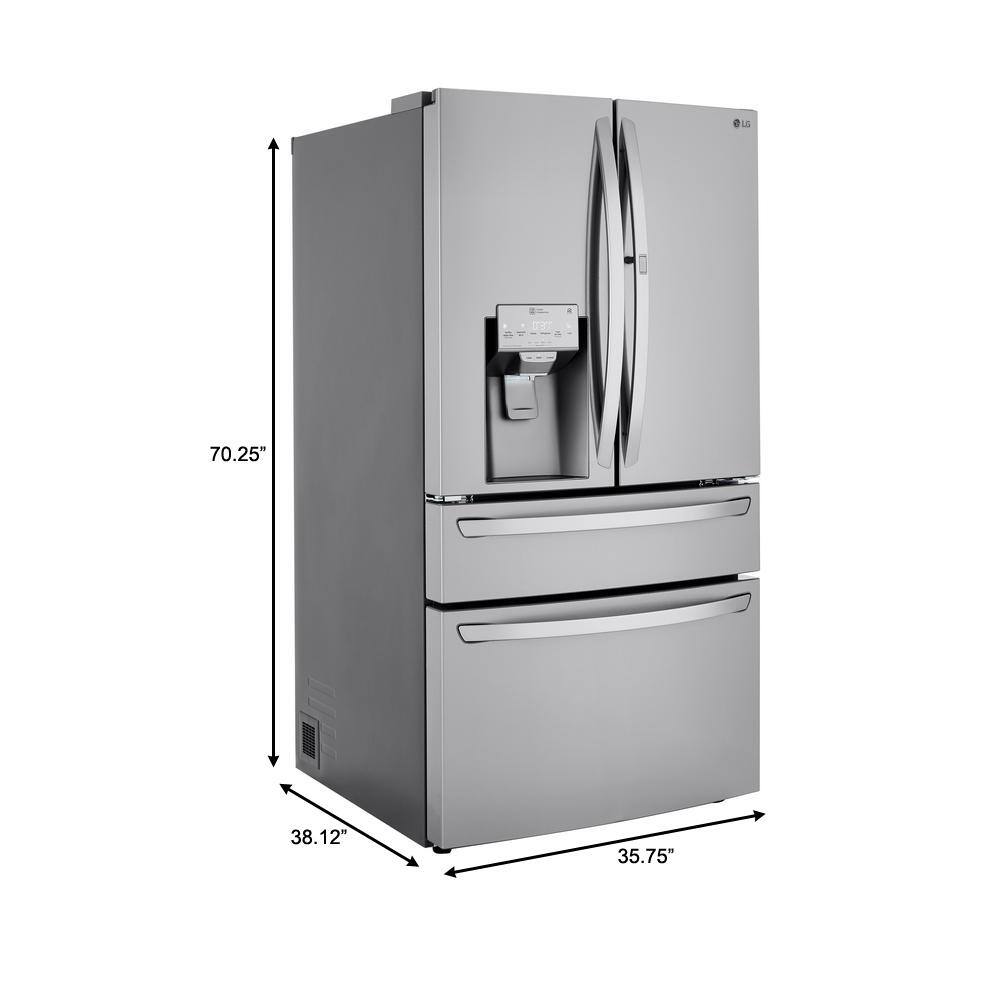LG Electronics 21.8 cu. ft. French Door Refrigerator with External Water Dispenser in Stainless Steel
Four Spill Protector tempered glass shelves for easy cleanup. Smart Cooling System designed to help keep food fresh for longer. 10-year manufacturer’s limited warranty on linear compressor.
You don’t have to sacrifice style when shopping for smaller kitchen spaces. With a generous 21.8 cu. ft., LG’s stylish French door refrigerator gives you 10% more capacity in the same 30 in. wide.
- Smart cooling system is designed to maintain superior conditions within the refrigerator
- Linear compressor reacts quickly to temperature fluctuations and helps keep your food fresher, longer
- Strategically-placed vents in every section help to surround your food with cool air no matter where you put it
- Get more space for groceries in a great feature-packed refrigerator
- Generous 22 cu. ft. of space, you’ll have room and room to grow
- Multi-Air flow system is designed to maintain superior humidity and temperature levels to help keep your food fresher, longer
- Digital sensors constantly monitor conditions within the refrigerator
- 2-Tier organization freezer
- SmartDiagnosis helps the service center diagnose problems over the phone, helping you troubleshoot quickly
- LG confidently backs the motor with a 10-year limited warranty on linear compressor
- 4 split shelves in refrigerator
- 7 total door bins
- Factory installed ice maker and water dispenser
- Energy Star
Additional information
| Depth (Excluding Handles) | 33 in |
|---|---|
| Depth (Including Handles) | 35.5 in |
| Depth (Less Door) | 29 |
| Depth With Door Open 90 Degrees (In) | 44.75 |
| Height to Top of Door Hinge (in.) | 68.5 |
| Height to Top of Refrigerator (in.) | 67.25 |
| Product Depth x Height x Width (in.) | 35.5 x 68.5 x 29.75 |
| Refrigerator Width (In.) | 29.75 |
| Certifications and Listings | ADA Compliant,CSA Listed,Energy Star |
| Manufacturer Warranty | 1 Year Parts and Labor, 7 Years on the Sealed System, 10 Years on Linear Compressor |






by Karen
Its prefect. I got it for my Daughter. she was just over joyed. I like the way its set up. The way it functions. Every thing about it seems this fine. The guys delivered move my old Refrigerator, put this one together and was off.
by Fidel
I am very happy is perfect thank you.
by Greg
This LG fridge is a great addition to my kitchen as I start to transition/update to stainless. I love the LED lights, the removed shelves inside and on the doors! Thank you HD and LG!!
by Alison
If you have a small space, this is your fridge. I love it. I replaced my traditional fridge in the bottom, freezer on the top with this beauty and I couldn’t be more happy. You don’t realize how much of a hassle those old fridges are until you get a new French door fridge. No more bending down and digging in the back, everything is at eye level. It’s quiet, only runs the compressor like once a day. The ice maker is quick and relatively quiet.
by Melody
Love it. Makes my kitchen look so much bigger with all the shine. The only thing the skinny pull out drawer is freezing items in the very back. I not sure what temp to have frig or freezer. For some reason I’m having trouble keeping freezer front streak free but not the frig doors. With time I’ll figure it all out.
by Mike
Love water dispenser, Dependable, and very quiet looks great
by Tina
Bought this frig about 6 months ago. Overall, I am pleased with the refrigerator. Only issue is the flap between the French door does not always open fully when opening doors. So when you go to close door you have to manually push flap into correct position to close doors. Was repaired once to adjust flap which did not solve problem. Second repair to replace flap which helped to a degree but flap still does not reposition itself correctly 100% of the time. Super annoying and inconvenient.